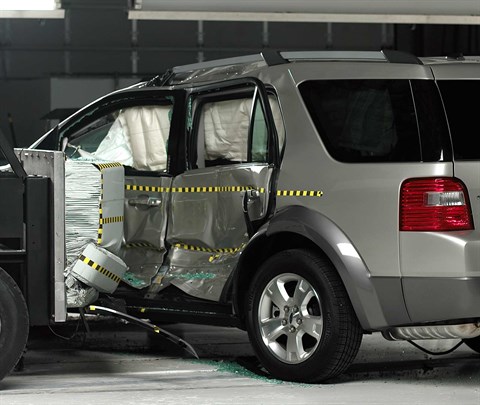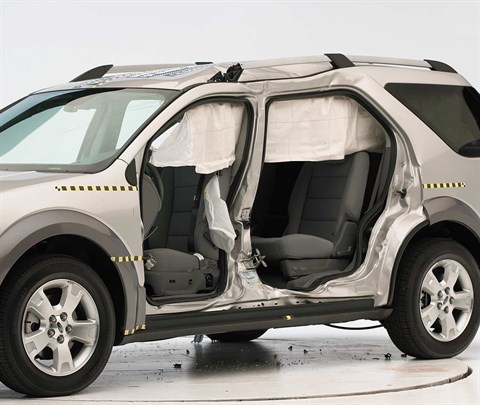Moderate overlap front: original test
Rating applies to 2008-09 models
Tested vehicle: 2008 Ford Taurus X SEL 4-door 4wd
The Ford Taurus X was re-engineered with a new engine for the 2008 model year. In addition, electronic stability control was added as a standard feature beginning with the 2008 models. Frontal ratings are assigned by the Institute based on a test conducted by Ford. This vehicle was known as the Ford Freestyle in the 2005-07 model years.
| Evaluation criteria | Rating |
|---|---|
| Overall evaluation | |
| Structure and safety cage | |
| Driver injury measures | |
| Head/neck | |
| Chest | |
| Leg/foot, left | |
| Leg/foot, right | |
| Driver restraints and dummy kinematics | |
Measures of occupant compartment intrusion on driver side
| Evaluation criteria | Measurement |
|---|---|
| Test ID | VTF0705 |
| Footwell intrusion | |
| Footrest (cm) | 5 |
| Left (cm) | 7 |
| Center (cm) | 8 |
| Right (cm) | 10 |
| Brake pedal (cm) | 1 |
| Instrument panel rearward movement | |
| Left (cm) | 3 |
| Right (cm) | 2 |
| Steering column movement | |
| Upward (cm) | -1 |
| Rearward (cm) | 0 |
| A-pillar rearward movement (cm) | 0 |
Driver injury measures
| Evaluation criteria | Measurement |
|---|---|
| Test ID | VTF0705 |
| Head | |
| HIC-15 | 156 |
| Peak gs at hard contact | no contact |
| Neck | |
| Tension (kN) | 1.2 |
| Extension bending moment (Nm) | 12 |
| Maximum Nij | 0.25 |
| Chest maximum compression (mm) | 36 |
| Legs | |
| Femur force - left (kN) | 3.0 |
| Femur force - right (kN) | 2.4 |
| Knee displacement - left (mm) | 1 |
| Knee displacement - right (mm) | 2 |
| Maximum tibia index - left | 0.34 |
| Maximum tibia index - right | 0.55 |
| Tibia axial force - left (kN) | 1.5 |
| Tibia axial force - right (kN) | 1.4 |
| Foot acceleration (g) | |
| Left | 53 |
| Right | 64 |
Side: original test
Rating applies to 2008-09 models
Tested vehicle: 2007 Ford Freestyle SEL 4-door 4wd with optional head curtain airbags for all three rows of seats and optional front seat-mounted torso airbags
The Ford Freestyle was introduced in the 2005 model year. The vehicle was re-engineered with a new engine for the 2008 model year and renamed the Ford Taurus X. In addition, electronic stability control was added as a standard feature beginning with the 2008 models. The engineering changes do not affect side impact performance.
Side airbags were made standard in all 2007 Freestyle models manufactured after September 2006 (side airbags were optional in 2005-07 models built in September 2006 or earlier). Note: information about when a specific vehicle was manufactured is on the certification label typically affixed to the car on or near the driver door. Beginning with 2008 models, all Taurus X models also have standard side airbags.
| Evaluation criteria | Rating |
|---|---|
| Overall evaluation | |
| Structure and safety cage | |
| Driver injury measures | |
| Head/neck | |
| Torso | |
| Pelvis/leg | |
| Driver head protection | |
| Rear passenger injury measures | |
| Head/neck | |
| Torso | |
| Pelvis/leg | |
| Rear passenger head protection | |

View of the vehicle and barrier just after the crash test.

View of the vehicle after the crash with doors removed, showing the side airbags and damage to the occupant compartment.

Smeared greasepaint shows where the driver dummy's head was protected from being hit by hard structures by the side airbags.

Smeared greasepaint shows where the rear passenger dummy’s head was protected by the side airbag.
Measures of occupant compartment intrusion on driver side
| Test ID | CES0631 |
|---|---|
| B-pillar to longitudinal centerline of driver's seat (cm) | -12.0 |
| Negative numbers indicate the amount by which the crush stopped short of the seat centerline. | |
Driver injury measures
| Evaluation criteria | Measurement |
|---|---|
| Test ID | CES0631 |
| Head HIC-15 | 163 |
| Neck | |
| Tension (kN) | 1.3 |
| Compression (kN) | 0.3 |
| Shoulder | |
| Lateral deflection (mm) | 52 |
| Lateral force (kN) | 2.0 |
| Torso | |
| Maximum deflection (mm) | 49 |
| Average deflection (mm) | 41 |
| Maximum deflection rate (m/s) | 5.39 |
| Maximum viscous criterion (m/s) | 0.91 |
| Pelvis | |
| Iliac force (kN) | 1.9 |
| Acetabulum force (kN) | 3.6 |
| Combined force (kN) | 5.2 |
| Left femur | |
| L-M force (kN) | 0.5 |
| L-M moment (Nm) | 55 |
| A-P moment (Nm) | 15 |
Passenger injury measures
| Evaluation criteria | Measurement |
|---|---|
| Test ID | CES0631 |
| Head HIC-15 | 71 |
| Neck | |
| Tension (kN) | 0.5 |
| Compression (kN) | 0.5 |
| Shoulder | |
| Lateral deflection (mm) | 39 |
| Lateral force (kN) | 2.0 |
| Torso | |
| Maximum deflection (mm) | 43 |
| Average deflection (mm) | 25 |
| Maximum deflection rate (m/s) | 3.58 |
| Maximum viscous criterion (m/s) | 0.68 |
| Pelvis | |
| Iliac force (kN) | 1.8 |
| Acetabulum force (kN) | 3.7 |
| Combined force (kN) | 4.9 |
| Left femur | |
| L-M force (kN) | 0.8 |
| L-M moment (Nm) | 63 |
| A-P moment (Nm) | -21 |
Head restraints & seats
Seat type: All seats
| Overall evaluation | |
|---|---|
| Dynamic rating | |
| Seat/head restraint geometry |
| Seat type | All seats |
|---|---|
| Geometry | |
| Backset (mm) | 42 |
| Distance below top of head (mm) | 50 |
| Seat design parameters | |
| Pass/fail | Pass |
| Max T1 acceleration (g) | 10.4 |
| Head contact time (ms) | 61 |
| Force rating | 1 |
| Neck forces | |
| Max neck shear force (N) | 57 |
| Max neck tension (N) | 514 |
About the head restraint & seat test
Currently, IIHS tests apply only to front seats.
